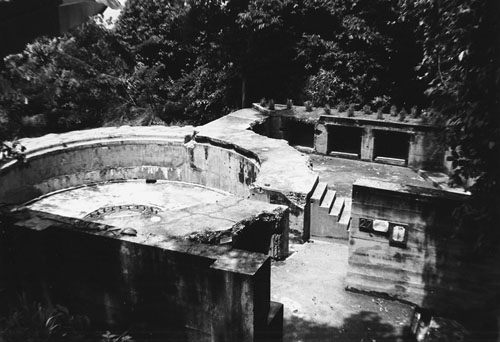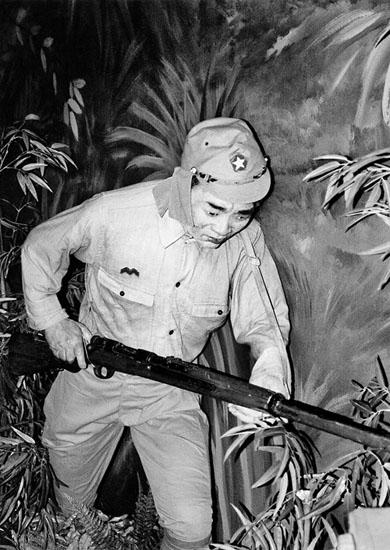Battle Story (7 page)
Authors: Chris Brown


L
ANCHESTER
A
RMOURED
C
AR
The first Lanchester armoured cars entered service with the British Army in 1929. Lanchesters had a nominal top speed of about 50mph and a range of about 250 miles. They were armed with two .303 Vickers guns and one 0.5 calibre Vickers. In North Africa, Lanchesters proved to be obsolete and a considerable number were sent to India and the Far East. The story goes that Colonel Ian Stewart of the Argyll and Sutherland Highlanders found that there were some in store on Singapore and promptly ‘acquired’ them and put them to use in exercises with his battalion.
C
HI
-H
A
T
ANK
Designated the Type 97 from the Imperial year of 2597. The original main armament was a low-velocity 57mm gun, later exchanged for a high-velocity 47mm gun with better armour-piercing capability. The Chi-Ha was also equipped with two 7.7mm machine guns, one on the hull of the vehicle, the other mounted facing backwards from the turret – a very unusual arrangement. The turret armour was 25mm (1in) thick on the turret, which made the Chi-Ha very vulnerable to even light anti-tank weapons. The 21.7L diesel engine gave the 15-ton Chi-Ha a top speed of 24mph and a range of about 160 miles. Over 1,000 Chi-Ha tanks were built and they saw service in Malaya with 1st, 6th and 14th Tank Regiments.

19. A speeding Ha-Go Type 95 tank.
H
A
-G
O
T
ANK
Production of the Type 95 Ha-Go, also known as the Kyu-Go, was the most common Japanese tank of the Second World War, with over 2,300 vehicles produced between 1935 and 1943, including a field engineering crane and an amphibious version. Ha-Go tanks were at least as good as any light tank in the world when they were introduced in 1935, and were a match for the Honey (or Stuart) tanks they encountered in Burma and the Pacific in terms of speed and manoeuvrability. The Ha-Go was driven by a 14L Mitsubishi diesel engine and armed with a 37mm gun and two 7.7mm machine guns. Some hundreds of Ha-Go tanks were captured by Chinese forces at the end of the Second World War and they saw extensive service in the Chinese Civil War between the Nationalists and the Communists.
In addition to the problems with shortages, poor equipment and inadequate training, the Allied commanders underestimated the Japanese to a ridiculous degree. To some extent this was simply racism. The notion that the Japanese were short, were poor physical specimens generally, had poor eyesight and that their equipment was bad was compounded by faulty strategic and tactical analysis. Japan had already been at war for some years and gained a wealth of experience, but Westerners did not see Chinese forces as serious opposition. The fact that Japan had been roundly defeated by the Soviet Union in 1938 and that now – at the end of 1941 – the Russians were being heavily beaten by the Germans did not mean that the Japanese were incompetent, but that was the general perception of the British military establishment.
None of this was helped by a policy position at Westminster that can only be described as wishful thinking. The assumption that there would not be war in the East ignored the possibility that Japan might see the European war as an opportunity.
By the time General Yamashita’s troops reached Johore, very little of any value had been done to prepare Singapore for a siege. Claims that Singapore was an ‘impregnable fortress’ bore no relation to reality. There were a number of defensive installations dating from the construction of the Singapore naval base. A dozen batteries had been erected and equipped with 6in or 9.2in guns, but they had all been located on the southern coast of the island, on the assumption that any threat to Singapore would come from the sea, not overland from Malaya. By good fortune it transpired that most of the guns would be able to fire to the north, but there was a severe shortage of suitable ammunition. The majority of the supply available consisted of armour-piercing shells that would be effective against ships; there was very few of the high-explosive shells required to break up attacks on land.

20. Pre-war concrete emplacement for a 9.2in gun. (Author’s collection)
In the last weeks of the campaign on the mainland some effort was made to provide defences on the northern shore, but little progress was made. It was difficult to procure labour since the civil authorities would not allow Percival to pay an adequate wage. An attempt was made to keep the preparations secret from the community for fear that there would be a decline in morale, though it was obviously impractical to maintain security with so many people working on defences. Such work as was undertaken was increasingly at risk from Japanese air attacks. When the bombers came into view, the labourers would scatter and it was very difficult to persuade them to go back to work if there was not going to be any friendly air cover. A number of concrete machine-gun positions had been built in the 1930s and a few more once the campaign started, but they were few in number and far too widely scattered.
Much more could have been done to protect the island; mines and barbed wire were available in the sense that there were extensive stocks of both, but poor record keeping meant that no one knew where they were stored and a general lack of urgency meant that no one tried very hard to find them. In the final days before the battle there was a little more urgency, but some of the arrangements and propositions smacked of fantasy. There were not enough searchlights to cover all the likely landing areas and there were plans to use car headlights. Providing power for headlights other than by leaving them mounted on cars with the engines running would obviously be a challenge, but the illumination would have been marginal anyway.
The civil defence arrangements were equally poor. During the first air raid on the city all the lights were left on because no-one knew how to swtich them off, aircraft were not scrambled for fear of friendly fire and there was a general lack of night-fighter training. There was very little in the way of an Air Raid Precautions (ARP) system and very few shelters. The latter was, admittedly, something of a challenge given the very low water table: the floors of even relatively shallow slit trenches tended to become a soggy quagmire in no time at all.
The appointment of a resident minister to ensure all was being done that could be done did not help. Sir Alfred ‘Duff’ Cooper arrived in 1941 but found he was obstructed at every turn by the governor, Sir Shenton Thomas. Cooper probably did not have the relevant skills or experience to make a great impression on the situation, and he certainly did not have the powers to do so. Although he did manage to secure the appointment of one person to co-ordinate all civil defence efforts in Singapore and Johore, Shenton Thomas ensured that the appointee – Brigadier Simpson – was denied the powers to do the job. Other than a desire to preserve his own authority as governor in all matters, it is impossible to see why Thomas should have been so obstructive; however, he did not get on well with Cooper and may have acted out of nothing more than resentment.
The general ethos of the Japanese Army could hardly have been more different to those of Britain, India or Australia. Encouraged to be self-reliant and treated with ruthless brutality, the Japanese soldiers’ training instilled confidence in battle and a high degree of physical fitness. Prior to the invasion, only one regiment had engaged in any degree of jungle training, so the average Japanese soldier was no more familiar with the combat environment than his British or Indian counterpart; the difference was that he had been taught not to fear the jungle, whereas most Allied troops had been conditioned to avoid it.
Japanese Army staff work and the ability to improvise had been honed by years of fighting in China, where considerable distances and a poor transport infrastructure posed major problems with supplies. The term ‘army’ as in ‘Twenty-Fifth Army’ really equates to the term ‘corps’ in other armies. An ‘army’ was not so much a permanent administrative structure as a group of divisions brought together for a particular campaign. The Twenty-Fifth Army consisted of the three infantry divisions, 5th, 18th and the
Imperial Guards, supported by elements of four medium and light tank regiments.

21. Waxwork effigy of a Japanese soldier with an Arisaka rifle at the Si!oso Fort
Museum, Singapore.
The Japanese divisional structure varied considerably throughout the war and from one theatre to another, but 5th and 18th Divisions in 1941 each had two infantry brigades, each of two regiments comprising three battalions; some twelve infantry battalions in total. Each division had an artillery regiment, a reconnaissance unit and various divisional troops. The Imperial Guards Division and 5th Division were entirely motorised, but 18th Division’s transport was horse drawn and the reconnaissance unit was a cavalry battalion. The division started the campaign with nearly 6,000 horses, which may seem anachronistic, but in fact almost all of the German divisions other than those in North Africa had horse-drawn transport and artillery throughout the Second World War. The Guards Division had nine battalions in three regiments and although the formation enjoyed a certain status, it was, arguably, the least effective of the three divisions in the Twenty-Fifth Army.
With about thirty officers and a little over 1,000 men at full strength, the Japanese infantry battalion was rather larger than its Commonwealth counterpart and consisted of a headquarters company, a machine-gun company and four rifle companies. The companies, again bigger than their Commonwealth equivalent, had a headquarters company, three rifle platoons each with three squads of thirteen men commanded by a corporal or sergeant, and a grenade discharger squad of thirteen men to give a total company roll of about 200. The standard rifle was the Type 99 Arisaka, a bolt-action weapon of 7.7mm calibre; however, some of the earlier Type 38 models (6.5mm calibre) were still in use, which complicated ammunition supply. The Japanese infantrymen had a rather ramshackle appearance which belied their fighting ability. Their cotton uniforms came in a wide variety of shades of khaki, green and grey, and the puttees worn by many gave them a somewhat old-fashioned look. Steel helmets were issued as standard, but some chose to wear ‘solar topi’-type sun helmets. Soft rubber-soled shoes were popular and gave the advantage of virtual silence on the battlefield, but most soldiers wore slightly curious footwear with a separation to accommodate the big toe.
